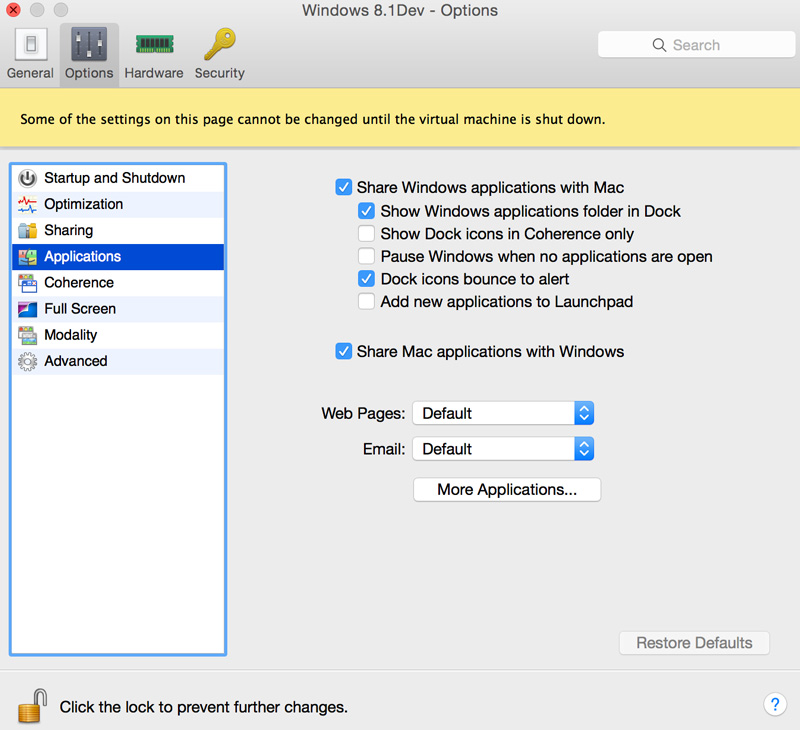It takes advantage of your Mac's ability to respond to more than one IP address on its Ethernet or wireless connection port. In essence, one IP address will be used for your Mac, and a separate IP address will be assigned to the Windows virtual machine. Parallels Desktop for Mac Standard Edition; Parallels Desktop for Mac Pro Edition; Parallels Desktop for Mac Business Edition; Parallels Desktop Lite. There is no internet connection in the virtual machine after updating Parallels Tools. 3rd party network related drivers presence.


I have two virtual machines running on Parallels desktop (v11 if that makes a difference). They are operating in Shared network mode.
When I have a wireless or Bluetooth network connection they can communicate between each other fine.
Parallels For Mac Review
When I lose that connection (phone tether drops out, flying, etc) the virtual machines no longer are able to communicate with each other.
I have also tried the network in Host Only mode to no avail.
Is there some way I can have these virtual machines communicate with each other even when I do not have an external network connection?
1 Answer
From Parallels Knowledge Base the following indicates an internet connection is required for this to work. No idea why that would be a requirement.
You must log in to answer this question.
Not the answer you're looking for? Browse other questions tagged networkwifivirtualizationparallels-desktop .
I have a macbook pro. Recently I installed parallels desktop on it. But the problem i have is when I connect a usb device to my macbook it is not being detected in the windows parallel desktop. Also I have no idea how to get right click options in the parallel windows desktop. Can you please help me. Thank you for your help in advance.
I have to admit that I was stymied for a long time about how to right-click within Parallels, a great virtualization application available for Mac OS X that lets you run Microsoft Windows XP, Windows Vista, Linux and a variety of other operating systems within Mac OS X. Plug in an external two-button mouse, of course, and the right click just works, but within Parallels?
The secret is to hold down the Control-Shift buttons when you click on the mouse within Parallels. I found that out by actually reading their documentation (imagine!) after puzzling through the problem for far too many hours. Your Control key might well be labeled “Ctrl” on your MacBook Pro, as it is with mine, of course.
The USB device question is straightforward too. In the Preferences for Parallels you can specify whether you want USB devices to be auto-connected upon detection or not. Sounds like you have this option turned off. To change it, you need to shut down your virtual machine, if it’s running, and then choose Edit –> Virtual Machine…, within which you’ll find one of the options is:

On mine you can see that I have my Connection Options set to “Connect to Guest OS”: yours is set to “Connect to Mac OS” instead. A good third alternative, by the way, is to simply choose the option “Ask me what to do”, which means that every time it detects a new USB device, you’ll have the option of letting Parallels have it or let Mac OS X have it.
Finally, if you are running Parallels and you find that your USB devices are being captured by Mac OS X but not your virtual guest OS, you can also go to the Devices menu, find the peripheral in question, and choose it to have Parallels wrest control from Mac OS X and hand it to your guest operating system. If the peripheral is checked, Parallels owns it, and if it’s not checked, the Mac operating system owns it:
As you can see, Parallels has stolen control of my Apple iPhone from the Mac operating system and the Mac side can’t see it. Interestingly, when hooked up this way, the phone doesn’t appear to charge from the USB connection, but when I release it from Parallels (by simply selecting it in this Devices menu) it syncs up with iTunes on my Mac and charges from the USB cable too.
That should get you going a bit more efficiently with Parallels. Enjoy!